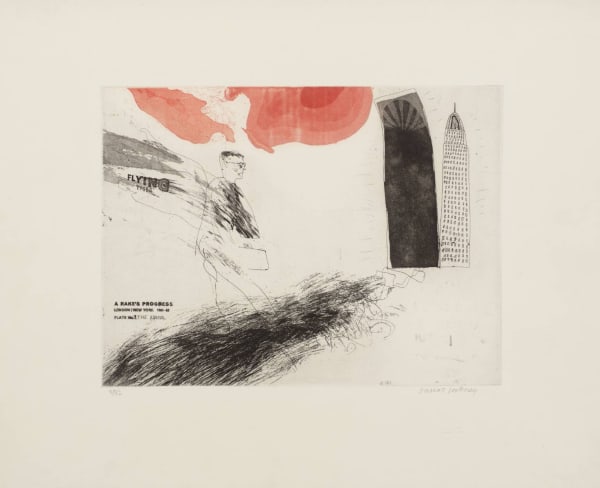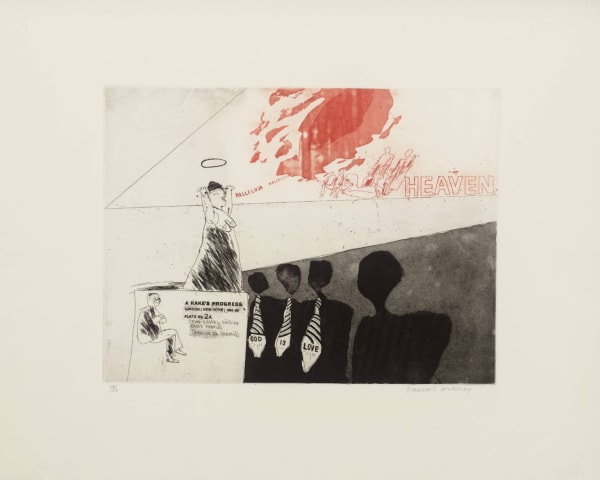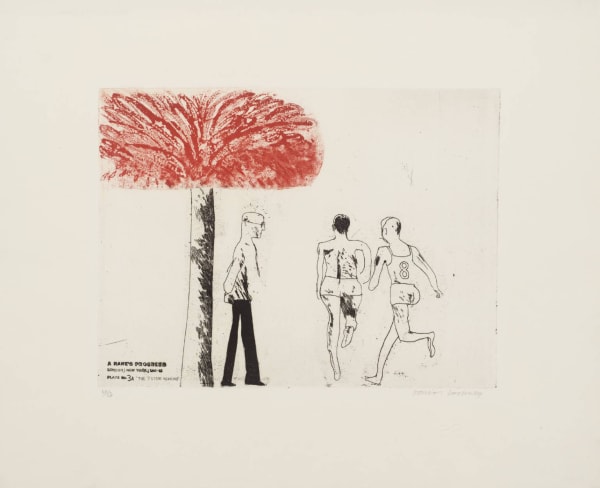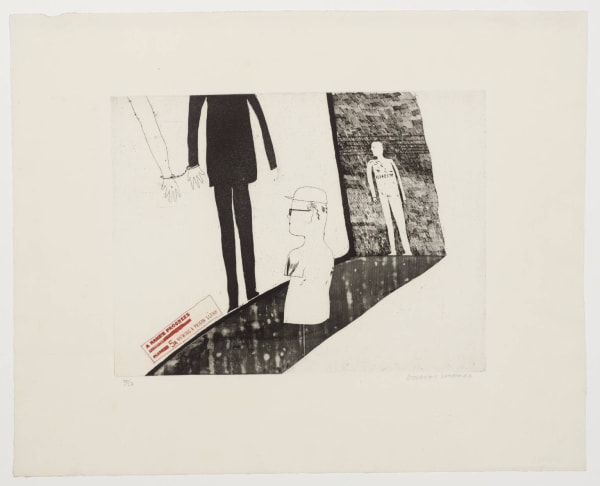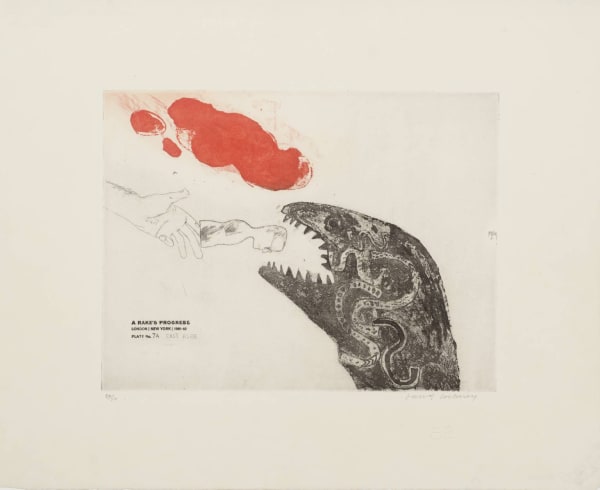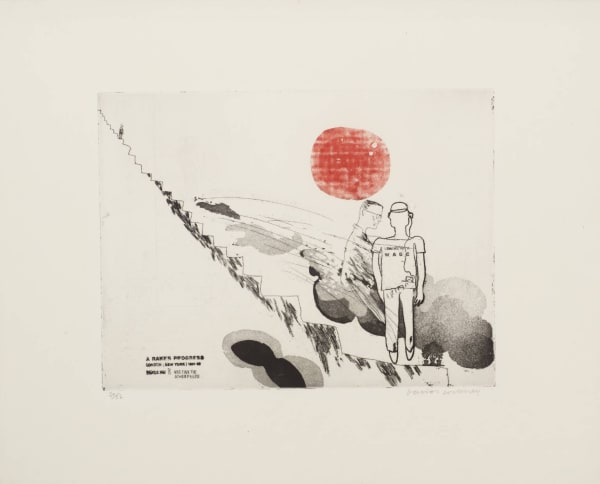-

-
-

The Arrival
(M.C.A.T 12)View more -

Recieving the Inheritance
(M.C.A.T 13)View more -

Meeting the Good People (Washington)
(M.C.A.T 14)View more -

The Gospel Singing (Good People)
(M.C.A.T 15)View more -

The Start of the Spending Spree and the Door Opening for the Blonde
(M.C.A.T 16)View more -

The Seven Stone Weakling
(M.C.A.T 17)View more -

The Drinking Scene
(M.C.A.T 18)View more -

Marries an Old Maid
(M.C.A.T 19)View more -

The Election Campaign (Dark Message)
(M.C.A.T 20)View more -

Viewing a Prison Scene
(M.C.A.T 21)View more -

Death in Harlem
(M.C.A.T 22)View more -

The Wallet Begins to Empty
(M.C.A.T 23)View more -

Disintegration
(M.C.A.T 24)View more -

Cast Aside
(M.C.A.T 25)View more -

Meeting the Other People
(M.C.A.T 26)View more -

Bedlam
(M.C.A.T 27)View more
-
-
David Hockney A Rake's Progress series
“The moment you can learn to deal with homosexuality in art, it's quite an exciting moment, just as in a sense when people 'come out' it's quite an exciting moment. It means they become aware of their desires and can deal with them in a remarkably honest way.” David Hockney
David Hockney’s breadth of artwork – etchings, drawings, prints, paintings, photographic collages, stage design – is matched by the wide-ranging cultural influences imbued into many of his most famous pieces. A Rake’s Progress, 1961-1963, is both one of Hockney’s most creative and most personal series of works: inspired by the well-known 1735 engraving series by William Hogarth that mocked the life of a wealthy man-about-town, whose life descended into squalor, Hockney transformed the original tale into his own outsider’s story of a young gay artist, visiting New York City for the first time, and struggling to find his identity. Hockney actually started this series at Royal College of Art, having visited the Big Apple that summer of 1961, ‘My first visit to America was something very special to me,’ and continued to create the etchings until 1963. Of course, A Rake’s Progress is also the name of Igor Stravinsky’s famed 1951 opera, and later in his career, Hockney created the set design for the 1975 rendition of the opera at Glyndebourne, UK.
David Hockney’s A Rake’s Progress is a 16 etching series depicting mis-en-scene narratives full of colour, richly defined characters, distinctive interior and landscapes that received critical popularity. It is also a seminal series in Hockney’s long and varied career, which evolved his storytelling style through experimentation with composition and form.
Hockney unusually turns inwards expressing his semi-autobiographical ‘Rake’ as a young gay artist, confused by his identity, his place in society, and the direction of his art career. “The moment you can learn to deal with homosexuality in art, it's quite an exciting moment, just as in a sense when people 'come out' it's quite an exciting moment. It means they become aware of their desires and can deal with them in a remarkably honest way.”
Whilst the 16 etchings are each individual prints, Hockney enjoys working with the linearity style of etching, which like drawing enables him to create an extended narrative across a series: Hockney’s A Rakes Progress starkly contrasts the ornament of Hogarth’s work instead depicting pared back compositions mainly in monochrome, although bold explosions of red add dramatic impact to The Arrival, The Wallet Begins to Empty, The Seven Stone Weakling. The purposeful use of monochrome ensures the viewers gaze is focused on the subject matter, whilst the punches of fiery red deliberately suggest passion, danger and emotional intensity. Some of Hockney’s depictions are immediate in their exploration of his outsider status, ‘Cast Aside,’ ‘Disintegration.’ Whilst others, such as The Wallet Begins to Empty, require a viewer to decode the rich symbolism behind these surreal, complex artworks: the staircase merely serving as a narrative device to represent his descent into despair.
Hockney manages to depict characters that simultaneously feel like real life figures as well as archetypal representations: either way they are created as multi-dimensional characters carrying the emotional weight of societal rejection, isolation and lack of identity. The exaggerated figures and surreal scenarios set against grandiose landscapes heightens the sense of distortion when viewing the prints. However, as the narrative proceeds through the series, Hockney’s contemporary version of the ‘Rake’ has found his way through inner turmoil, confusion, to find sexual liberation and acceptance before descending again into despair (see Bedlam) – mirroring the famed story of Dante’s Divine Comedy, where the protagonist progresses through Hell, Purgatory and Paradise.
A Rake’s Progress weaves a narrative that contrasts and connects two artists working centuries apart: if Hogarth created a moral satire of an establishment dandy at a time of great social change in the 18th century, Hockney reinvented the tale for a time defined by a generation who challenged societal norms to ignite a sexual and cultural revolution. Both artists illustrate the timeless art tradition of using satire to critique political and social issues, Hockney’s nuanced satirical artworks paved the way for contemporary street artists, such as Banksy who added a dark humour to his publicly accessible paintings. (see Andipa viewing rooms)
A Rake’s Progress is a timeless series, in which Hockney creates a discourse between artists and artistic traditions through the lens of his own gay life experience. In fusing the narrative with a personal touch, A Rake’s Progress avoids becoming a general morality tale, instead taking the viewer along on a journey of intimate self-discovery.
-
-
Buy or sell A Rake's Progress Series at Andipa Editions
Buy David Hockney A Rake's Progress series
Andipa Editions, as part of Andipa, have been at the forefront of the Hockney market for over 20 years. To enquire about buying A Rake's Progress Series by David Hockney contact us via sales@andipa.com or on +44 (0) 20 7589 2371.
Sell A Rake's Progress Series by David Hockney
With a global network of active buyers, Andipa Editions are the place to sell your A Rake's Progress Series print. Straight-forward and stress-free, we manage the process on your behalf and help to maximise your return. For a complimentary valuation of your A Rake's Progress Series print, contact us via sales@andipa.com or on +44 (0) 20 7589 2371. Explore our collection of David Hockney original prints for sale.

